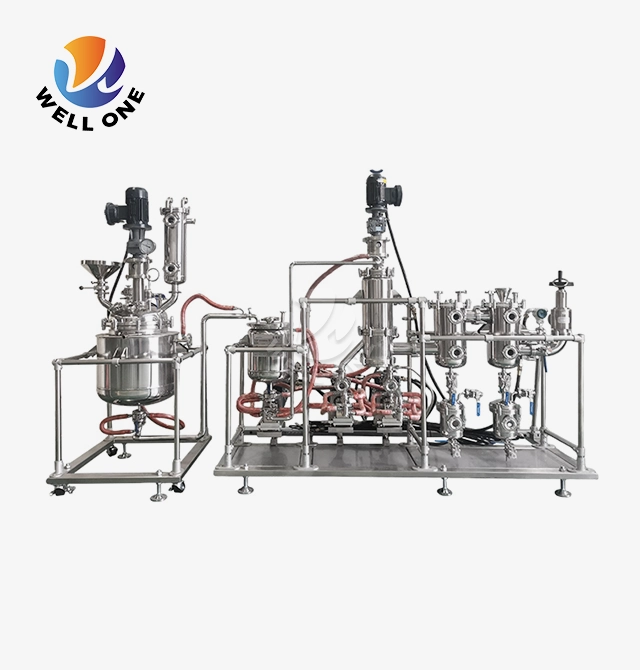How to Maintain and Clean an Agitated Thin Film Evaporator?
An Agitated Thin Film Evaporator (ATFE) is an important industrial equipment used for efficient evaporation and concentration of heat-sensitive liquids. It consists of heating and cooling zones, with a rotor that runs the liquid as a thin film along heated surfaces to facilitate rapid evaporation. Proper maintenance and regular cleaning of ATFEs is crucial for optimal performance, preventing fouling or contamination, ensuring safe operation, and extending equipment life.
Importance of Maintenance and Cleaning
Routine maintenance and cleaning preserves ATFE efficiency by preventing scale build-up and fouling, which can drastically reduce heat transfer rate, lower throughput, and increase energy consumption. It minimizes risks of unplanned downtime and production losses while ensuring end-product quality. Scheduled cleaning removes residues to prevent bacterial growth and contamination. Maintaining moving parts through lubrication and inspection reduces wear and tear. Overall, proper maintenance enhances reliability, safety, and longevity of ATFEs.
Understanding the Components of an ATFE
Key components requiring regular upkeep are the evaporator body, heating system, wiping mechanism, condenser, and liquid feed system. The cylindrical evaporator body, often stainless steel or glass-lined steel, contains the heating elements. Heating is through steam chests, half-pipe jackets, or electric systems. A shaft-driven rotating wiper mechanism forces the product into a thin film which is thrown against heated tubular walls or external heat transfer tubes. Vapors released are recirculated or condensed via water, air, or refrigerant condensers. Feed and discharge pumps regulate proper liquid levels.
Additional key aspects include instrumentation like temperature transmitters, pressure indicators, level controllers, and safety relief valves. The gearbox, bearings, shaft sealing system, motors, and conveyors also need monitoring. Utilities supplying steam, cooling water, electricity and plant air require verification.
Regular Inspection Procedures
Agitated Thin Film Evaporators have sections requiring periodic inspection - rotor clearances, gaskets, scraper blades, gears, rolling element bearings, motors, pumps, condensers, and heating systems. Checking for liquid leaks, odd sounds, or vibrations can identify issues early. Performance indicators like efficiency and heating medium/cooling water temperatures should be tracked. Scheduled lubrication, condition monitoring via oil analysis and vibration analysis, and non-destructive testing helps evaluate wear and tear. Routine inspections minimize risks of failure.
Inspections follow a plant's preventive maintenance plan with daily checks by operators and more rigorous annual overall inspections. External specialists can conduct in-depth condition assessments via methods like radiography tests, thermography, ferrography, acoustic emissions sensors etc. to detect abnormalities.
Recommended Cleaning Techniques
Flushing is used to remove loose residues. Caustic or detergent circulation cleaning eliminates organic residues most effectively. Mechanical methods like pressure washing, scrubbing and ultrasonication may sometimes be needed. Condensers require periodic cleaning via chemical circulation or mechanically brushing tubes. Copper condensers can be cleaned with citric acid solutions. For stubborn mineral scales, inhibited acid solutions work. Performed judiciously, chemical cleaning effectively restores performance. Proper PPE, safe chemical handling, containment of effluents, and appropriate disposal protocols are essential.
Cleaning methods balance effectiveness and risks like equipment corrosion. After visual examination, lab testing confirms residues. Cleaning agents are selected based on material compatibility. Online vs offline cleaning is chosen based on risks. Staff must have expertise in specialized cleaning techniques like high pressure nitrogen blasting.
Safety Protocols
Personnel safety is vital when cleaning Agitated Thin Film Evaporators. Systems must be fully isolated and de-energized with proper lock-out-tag-out procedures followed. Allowing systems to cool to safe temperatures is mandatory. Chemical reactions between incompatible cleaning agents can be extremely hazardous, hence compatible materials and concentrations should be ensured. Closed systems should be used for flammable/toxic chemicals. Exhaust ventilation and PPE including respiratory protection are necessary when exposure exceed safe limits. Moreover, facilities must comply with all waste disposal regulations.
Thorough purging post cleaning ensures no reactive remnants prior to starting up. Staff training, supervision of procedures and emergency drills promote safety. Plants require clearly visible signages, adequate space and specialized washing areas for large parts. Safety audits verify adherence to company standards and external regulations.
Preventive Maintenance Measures
Proactive maintenance like gasket replacements before leaks occur, lubrication of gears, bearings and pumps as recommended, calibration of instruments and replacing wearing parts avoids unforeseen breakdowns. Monitoring erosion and corrosion parameters allows addressing issues before equipment failure. Keeping fastener torque specifications helps prevent leaks. Offline cleaning after scheduled production runs keeps the system in good working condition. Staff training ensures proper O&M procedures are followed. Such measures maximize uptime.
Software analytics on process parameters identifies brewing problems. Critical parts have refurbishment/replacement timelines. Plants stock common spare parts, have machining/fabrication workshops and tie-ups with equipment OEMs for prompt troubleshooting support.
Troubleshooting Common Issues
Reduced efficiency, uneven heating, vibrations, motor overloading, and leakage problems are often faced. Efficiency issues can arise from scale deposits or fouling - addressed through cleaning based on visual inspection and sample analysis. Unstable films from improper level control, inadequate pumping capacity, or excess foaming requires adjusting operating parameters. Shaft seal and gasket leaks necessitate replacement. Pump cavitation, gear wear and tear, or rotor unbalance results in vibrations - fixed by realignments or part replacements after root cause analysis.
Interdisciplinary teams brainstorm likely failure modes from reported problems and derive solutions. Historically solved issues are collated in easily searchable databases to leverage past experience.
Professional Maintenance Services
While routine maintenance tasks can be performed by trained operators, it's prudent utilizing professional services periodically for health checks through thermography, vibration analysis or laser alignment. Complex part replacements like motors may also need external contractors. Offsite cleaning services should handle hazardous chemical cleaning procedures. Staffing limitations or lack of expertise makes professional services an attractive option for major maintenance jobs requiring specialized skills.
Shutdowns and revamps are planned annually/biannually when major renovations are bundled for efficiency. Technical consultants can propose newer technologies or designs to enhance reliability. Augmenting capabilities through partnerships is key for optimal Agitated Thin Film Evaporator functioning.
Spare Parts Management
Keeping sufficient spares like scraper blades, pumps, heating jackets, valves and instruments ensures quick resolutions of breakdowns. Codifying parts, detailing specifications, identifying OEMs, and tracking warranty periods aids inventory and lifecycle management. Computing ideal sparing levels based on criticality, equipment design and lead times provides availability when required. Modern strategies like 3D printing common wearing parts as needed reduces excessive stocks.
Waste Handling and Disposal
ATFE cleaning/maintenance generates significant effluents, hazardous wastes and used parts. Proper containment through drain guard systems, overflow tanks and bund walls prevents environmental releases especially for toxic/reactive fluids. Characterizing waste streams facilitates optimal reuse, recycling or disposal per regulations. Staff must transport, label and store waste safely prior to transfers to qualified collectors. Facilities incorporate waste volume reduction and green chemistry concepts to protect the ecology.
Energy Efficiency Considerations
Evaporators are highly energy-intensive; hence power/steam conservation is crucial. Insulated steam lines, variable frequency drives and upgrading older motors/pumps enhances efficiency. Recovering low-grade heat or integrating heat pumps lowers utility needs. Automation solutions like AI-powered predictive maintenance and process simulation models optimizes Agitated Thin Film Evaporator functioning. Renewable energy integration and detailed energy audits help achieve emission reduction targets.
Operator Training Programs
Skilled manpower is indispensable for ATFE excellence. Classroom and hands-on competency development through training calendars and cross-department job rotations build technical expertise. Simulators reproduce scenarios for troubleshooting rehearsals. Multi-level certification programs assess competence improvements over time. Such initiatives hone diagnostic abilities and best practice sharing within teams.
Enhancing Equipment Lifetime
Alongside preventive maintenance, asset performance enhancements prolong ATFE utility lifespan. Major aspects are improving corrosion resistance using special coatings, ZRA based inhibitors or cathodic protection systems. Enhancing resistance to erosion via fluid flow optimization or protective sleeve inserts reduces wear and tear. Periodic equipment re-rates after inspection handle production increases. Introducing redundancy for capacity sustenance allows staggered repairs. Such methods enhance equipment longevity.
Conclusion
The efficient functioning of Agitated Thin Film Evaporators relies heavily on regular maintenance and vigilant cleaning practices. Routine inspections enable early issue detection, while scheduled preventive maintenance minimizes wear and tear and equipment downtime. Appropriate cleaning maintains heat transfer rates and prevents contamination. Strictly adhering to safety protocols is crucial during maintenance and cleaning activities. Seeking technical expertise is recommended for complex servicing needs. Proactive and consistent ATFE upkeep sustains performance, prolongs work life, and averts process disruptions.
Xi'an Well One Chemical Technology Co., Ltd, an exclusive export agency authorized by NewSet, is a renowned Agitated Thin Film Evaporator manufacturer. With 17 years of production and manufacturing experience, we ensure the best quality of our products by choosing the finest raw materials and leveraging professional equipment and our research team. Our OEM & ODM services are backed by our 3D design engineers who can provide users with 3D animation design, tailoring the appearance of the equipment to user preferences. Our product line includes experimental level, pilot level, and industrial level molecular distillation devices, as well as multi-level continuous use systems. These products have been well received by customers from various countries. If you are considering purchasing related equipment, please feel free to contact us at Mobile: (+86) 18191320360 or Email: info@welloneupe.com. We look forward to cooperating with you.
References
1. Alopaeus, V., Laavi, H., & Prasad, K. (2018). Better understanding of ATFE for scaling up. Chemical Engineering Research and Design, 138, 309-317.
2. Brennan, L. B., Lei, M., O'Neill, M., Chen, X. D., & Earle, M. (2021). Review of fouling mitigation strategies in falling film evaporators during operation and cleaning. Food and Bioproducts Processing, 129, 1-12.
3. Rajendran, R. (Ed.). (2020). Preventive Maintenance and Equipment Reliability Handbook. McGraw Hill.
4. Shah, P. B. (2020). Basics of Agitated Thin Film Evaporators–A Complete Overview. Chemical Weekly, 66(3), 233-238.
5. Smith, R. L., Maloney, S. W., & Strilesky, P. F. (Eds.). (2002). Perry's Chemical Engineers' Handbook. McGraw-Hill.







